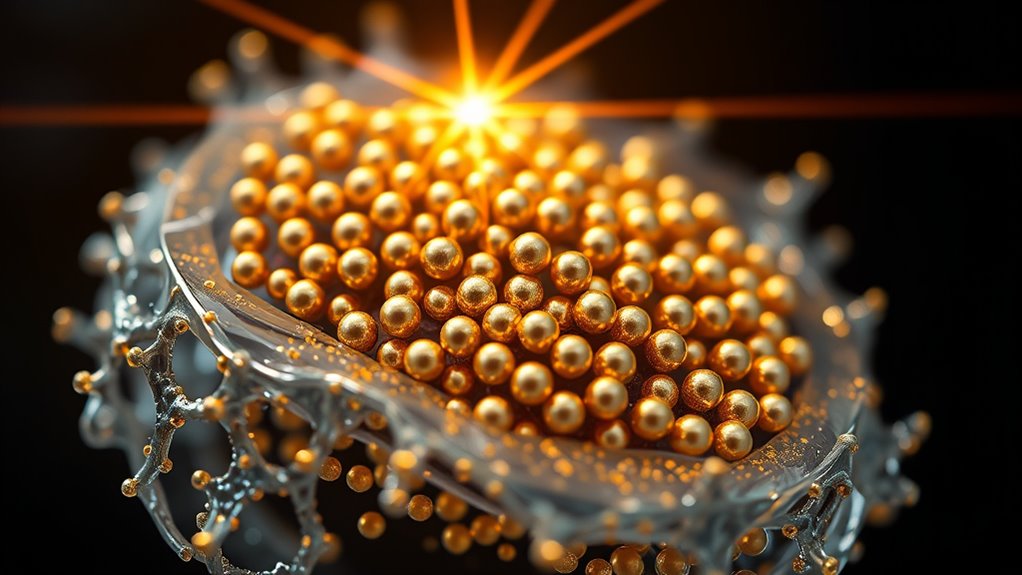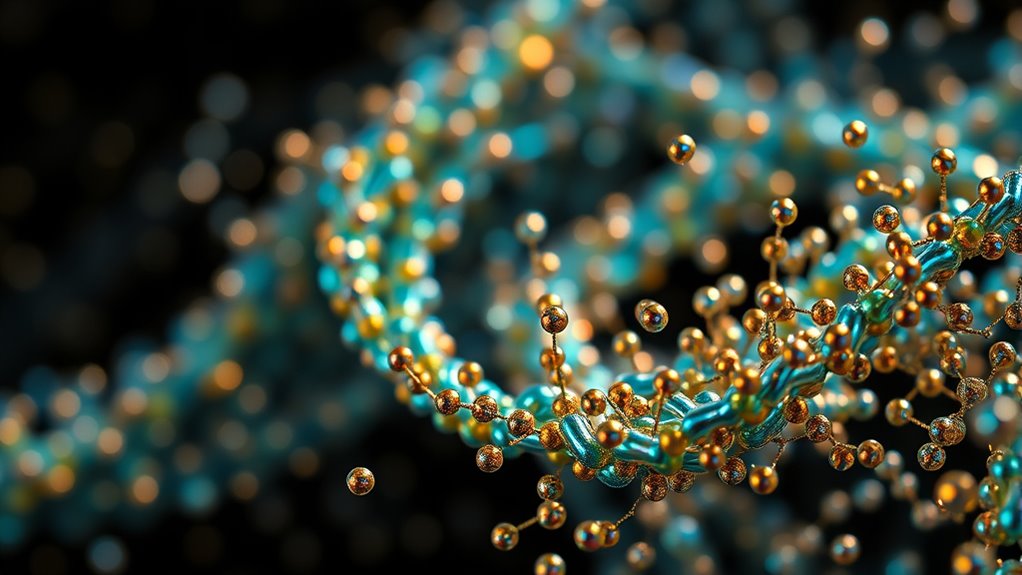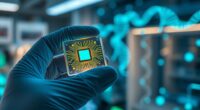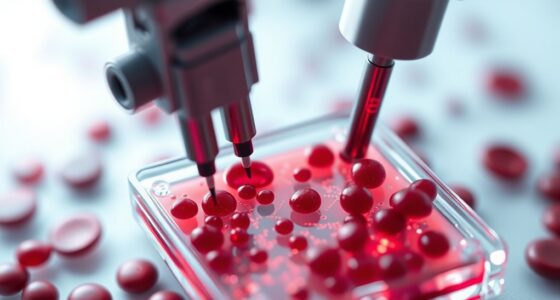Nanoparticles offer a promising way to deliver CRISPR gene editing tools safely and effectively. They act as carriers that protect genetic material and help it cross cellular barriers, reducing toxicity compared to traditional methods. By customizing their design with surface modifications, you can target specific cells while avoiding immune responses. Advances in this field improve precision and safety, and exploring these innovations will reveal how they can transform gene therapy for various diseases.
Key Takeaways
- Nanoparticles protect and transport CRISPR components efficiently into target cells, enhancing gene editing success.
- Surface modifications and targeting ligands improve delivery specificity and reduce off-target effects.
- Lipid and inorganic nanoparticles facilitate safe crossing of cellular barriers with minimal toxicity.
- Advances include real-time monitoring and functionalization to optimize safety and precision.
- Ethical, regulatory, and AI security measures are essential to ensure responsible and safe CRISPR nanoparticle delivery.
Understanding the Role of Nanoparticles in Gene Delivery

Nanoparticles play a crucial role in gene delivery by acting as carriers that protect genetic material and facilitate its transport into target cells. Their effectiveness depends on precise nanoparticle synthesis, which guarantees consistent size, charge, and stability. This process influences how well they can deliver CRISPR components and escape immune detection. Additionally, understanding the top projectors for gaming enthusiasts can provide insights into advanced material applications and technology integration relevant to nanoparticle design. However, you must also consider regulatory hurdles that can slow development. Regulatory agencies scrutinize nanoparticle synthesis methods for safety, reproducibility, and potential toxicity. Overcoming these hurdles requires thorough characterization and strict quality control. When you understand the importance of nanoparticle design and compliance, you can better navigate the path toward clinical applications. Ultimately, mastering nanoparticle synthesis and regulatory processes is essential for safe and effective gene delivery systems.
Types of Nanoparticles Used in CRISPR Applications

You’ll find that lipid-based nanoparticles are among the most common carriers in CRISPR applications because of their biocompatibility and efficiency. Polymer and inorganic nanoparticles also play vital roles, offering advantages like stability and targeted delivery. Exploring these different types helps you understand how they optimize gene editing efforts.
Lipid-Based Nanoparticles
Have you ever wondered how lipid-based nanoparticles facilitate gene editing? These nanoparticles excel because of their high liposome stability, which protects CRISPR components during delivery. Their unique ability to undergo lipid fusion allows them to merge seamlessly with cell membranes, releasing their cargo directly into the cytoplasm. This fusion process enhances delivery efficiency and reduces degradation risks. Lipid-based nanoparticles can be engineered with specific lipid compositions to optimize stability and fusion properties, ensuring the CRISPR system reaches its target effectively. Their biocompatibility minimizes immune responses, making them safer for in vivo applications. Overall, lipid-based nanoparticles combine stability and fusion capability, making them a powerful tool for precise and safe gene editing in diverse therapeutic settings.
Polymer and Inorganic Types
Polymer and inorganic nanoparticles play a crucial role in advancing CRISPR delivery systems due to their unique properties. Polymers are synthesized through various polymer synthesis methods, enabling customization for specific gene-editing needs. They efficiently condense nucleic acids and protect them during delivery, while their biocompatibility reduces toxicity risks. Inorganic nanoparticles, such as gold or silica, offer inorganic stability, ensuring they withstand physiological conditions without degradation. These particles can be functionalized easily, allowing targeted delivery to specific cells or tissues. Their robustness and stability make them excellent carriers for CRISPR components. Both types of nanoparticles improve delivery efficiency, minimize off-target effects, and enhance safety profiles, making them promising choices in gene editing therapies. Their versatility continues to drive innovation in nanoparticle-based CRISPR applications.
Advantages of Using Nanoparticles for CRISPR Delivery

Using nanoparticles for CRISPR delivery allows you to achieve efficient entry into cells, increasing the chances of successful gene editing. They also help minimize toxicity risks compared to traditional methods, making the process safer. These advantages make nanoparticles a promising tool for precise and safer gene editing applications. Incorporating soundscapes and auditory cues can further enhance delivery accuracy and improve overall outcomes.
Efficient Cellular Entry
Nanoparticles excel at crossing cellular barriers, making them highly effective carriers for CRISPR delivery. They achieve this through mechanisms like cell membrane fusion, which allows direct entry into the cell, bypassing traditional endocytosis pathways. Once inside, nanoparticles facilitate endosomal escape, preventing degradation in lysosomes and ensuring the CRISPR components reach their target efficiently. This ability to traverse cell membranes quickly and reliably enhances delivery efficiency, reducing the need for high doses and minimizing off-target effects. Their adaptable surface chemistry also allows customization to improve interactions with specific cell types, further boosting cellular uptake. Overall, nanoparticles’ capacity for effective cellular entry makes them a powerful tool for improving gene editing success rates while maintaining precision.
Reduced Toxicity Risks
One of the key advantages of nanoparticles in CRISPR delivery is their potential to reduce toxicity risks compared to traditional methods. Unlike viral vectors, nanoparticles often cause less nanoparticle toxicity, making them safer for patients. They can be engineered to improve biocompatibility, overcoming common biocompatibility challenges that lead to immune responses or cell damage. By carefully designing the surface properties and composition, you can minimize adverse reactions and target specific tissues more precisely. This reduces off-target effects and minimizes inflammation or toxicity. As a result, nanoparticles offer a promising platform for safer gene editing, allowing you to deliver CRISPR components effectively while keeping toxicity risks low. This safety profile enhances the potential for clinical applications and long-term treatments.
Strategies for Enhancing Targeting and Specificity

Enhancing targeting and specificity in nanoparticle-mediated gene editing is crucial for minimizing off target effects and improving therapeutic outcomes. You can achieve this by modifying surface ligands to direct nanoparticles precisely to specific cell types, reducing unintended edits. Using tissue-specific promoters or guide RNA designs also helps increase accuracy, ensuring CRISPR components act only where needed. Additionally, optimizing nanoparticle composition can lessen immune responses that might compromise delivery efficiency or cause adverse effects. By fine-tuning these strategies, you limit off target effects, which are a major concern in gene editing therapies. You also minimize immune responses that could hinder treatment or trigger inflammation. These targeted approaches make nanoparticle delivery safer and more effective, advancing the clinical potential of gene editing technologies. Incorporating electronic components like advanced sensors can further improve delivery precision and real-time monitoring of gene editing processes.
Overcoming Biological Barriers With Nanoparticle Carriers

Achieving precise gene editing in vivo requires overcoming multiple biological barriers that can impede nanoparticle delivery. Your nanoparticles face challenges like immune clearance, cellular uptake, and tissue penetration. To succeed, you need smart design strategies, such as surface modifications that evade immune detection and enhance targeting. However, addressing these barriers also raises ethical implications, especially concerning off-target effects and long-term safety. Regulatory hurdles add another layer of complexity, requiring thorough testing and validation before clinical use. Ensuring nanoparticles can navigate biological environments safely and effectively is vital, yet balancing innovation with oversight remains a challenge. Additionally, understanding AI security concerns related to nanoparticle deployment and monitoring is increasingly important to prevent unintended consequences. By overcoming these barriers, you move closer to safe, efficient gene editing therapies that respect both ethical standards and regulatory frameworks.
Current Challenges and Safety Considerations

Despite advancements in nanoparticle design, current challenges and safety considerations remain significant hurdles for gene editing therapies. Ethical concerns about editing human genes raise questions about long-term impacts, consent, and potential misuse. Safety risks include unintended off-target effects and immune responses, which could cause harmful side effects. Additionally, regulatory hurdles complicate development; agencies require extensive safety data before approving nanoparticle-based therapies. These regulations aim to prevent misuse and ensure patient safety, but they can slow down innovation. You must navigate these ethical and regulatory landscapes carefully, balancing the promise of gene editing with responsible oversight. Addressing these challenges is vital to making nanoparticle delivery systems both effective and safe for widespread clinical use. Furthermore, understanding the reliability and accuracy of these systems is crucial to prevent unintended outcomes and build public trust.
Recent Breakthroughs and Experimental Successes

Recent advances in nanoparticle technology have led to remarkable experimental successes in gene editing. Researchers have achieved efficient delivery of CRISPR components to target cells, with some studies demonstrating precise gene modifications in vivo. These breakthroughs showcase the potential for treating genetic disorders more safely and effectively. Additionally, understanding the delivery methods employed is crucial for optimizing therapeutic outcomes. These breakthroughs showcase the potential for treating genetic disorders more safely and effectively. However, ethical considerations remain a critical aspect, especially regarding off-target effects and long-term impacts. While scientific progress accelerates, regulatory hurdles also pose challenges, as agencies work to establish guidelines for nanoparticle-based therapies. Despite these obstacles, ongoing experiments continue to refine delivery methods, bringing us closer to clinical applications. These successes highlight the promise of nanoparticles in gene editing, but also emphasize the need for careful regulation to ensure safe translation into medical practice.
Future Perspectives and Clinical Potential

Looking ahead, the clinical potential of nanoparticle-mediated gene editing is increasingly within reach as technological advancements continue to improve delivery efficiency and specificity. These innovations could revolutionize treatments for genetic disorders, cancers, and infectious diseases. However, ethical implications remain a critical concern, especially regarding germline modifications and long-term effects. Addressing these issues is essential for public trust and responsible application. Additionally, regulatory hurdles must be overcome to ensure safety and efficacy before widespread clinical use. Developing clear guidelines and rigorous testing protocols will be crucial. While challenges exist, ongoing research suggests that nanoparticle-based gene editing could become a powerful tool in personalized medicine, transforming healthcare and offering hope for previously untreatable conditions.
Frequently Asked Questions
How Do Nanoparticles Compare to Viral Vectors in Gene Editing Safety?
You’ll find nanoparticles generally safer than viral vectors because they provoke a lower immune response, reducing potential complications. They also offer better targeting specificity, ensuring your gene editing efforts hit the right cells without affecting others. Unlike viral vectors, nanoparticles don’t integrate into the genome, minimizing risks of unintended mutations. Overall, they present a promising, safer alternative for delivering CRISPR, especially when safety is your top priority.
What Are the Long-Term Effects of Nanoparticle-Based Gene Delivery?
You might wonder about the long-term effects of nanoparticle-based gene delivery. While research is ongoing, you can expect good long-term stability if nanoparticles are well-designed, ensuring proper DNA release and minimal degradation. However, you should also consider potential immune responses, which could impact safety and effectiveness over time. Monitoring these effects helps optimize nanoparticle use, making gene editing safer and more reliable for future therapies.
Can Nanoparticles Cross the Blood-Brain Barrier Effectively?
Coincidentally, your question about nanoparticle crossing and brain penetration hinges on nanoparticle design. You can enhance their ability to cross the blood-brain barrier by optimizing size, surface chemistry, and targeting ligands. Well-designed nanoparticles can effectively deliver CRISPR components to the brain, improving gene editing precision. However, achieving consistent and safe brain penetration remains challenging, requiring ongoing research into nanoparticle properties and delivery strategies.
Are There Any Approved Clinical Nanoparticle-Based CRISPR Therapies?
Currently, there are no approved clinical nanoparticle-based CRISPR therapies. Regulatory approvals are still pending, as safety and efficacy data continue to be evaluated. Ethical considerations also play a significant role in advancing these therapies, ensuring responsible use. You should stay informed about ongoing clinical trials and regulatory updates, since researchers and authorities prioritize patient safety and ethical standards before approving such innovative treatments for widespread use.
How Scalable Are Nanoparticle Production Methods for Clinical Use?
You might think scaling nanoparticle production is a Herculean task, but it’s more manageable than you imagine. Advances in manufacturing techniques are rapidly overcoming production challenges, making large-scale, consistent, and cost-effective nanoparticle synthesis possible. While hurdles remain, current innovations are pushing us toward the goal of widespread clinical use, ensuring that producing these nanoparticles can meet global demand without breaking the bank or sacrificing quality, bringing gene editing closer to reality.
Conclusion
Imagine the future where nanoparticles gently carry your gene edits through the body’s bustling landscape, steering barriers with precision like a skilled traveler. As these tiny messengers open new possibilities, you can feel confident in safer, more effective therapies taking shape. With ongoing breakthroughs lighting the path, you’re on the cusp of a revolution—where gene editing becomes a seamless, transformative journey, opening doors to healing and hope you once only dreamed possible.









